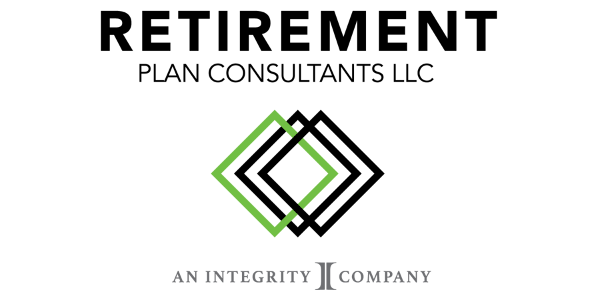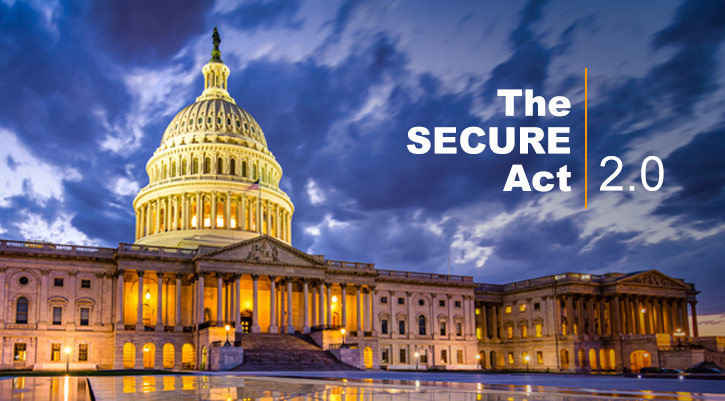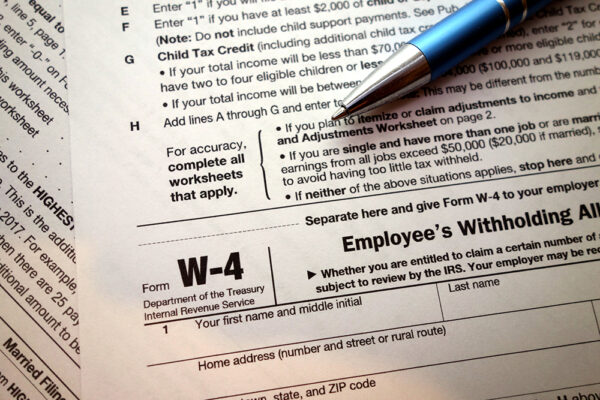Legislative Highlights
On December 29, 2022, the Consolidated Appropriations Act of 2023 was signed into law which included the highly anticipated Securing a Strong Retirement Act (SECURE 2.0). This Act brings major changes to the U.S. Retirement System and builds upon the enhancements that were implemented under the SECURE Act of 2019.
This legislation includes over 90 provisions taken primarily from three House and Senate Bills – (1) the Securing a Strong Retirement Act, (2) the Retirement Improvement and Savings Enhancement to Supplement Healthy Investments for the Nest Egg (Rise & Shine Act) and (3) the Enhancing American Retirement Now (EARN Act).
The provisions included in this legislation will take effect in varying years. This staggered approach gives plan sponsors and service providers more time to understand and implement these changes to their plans and recordkeeping systems.
The following is a high-level summary of selected provisions that are effective in 2023:
Modification of credit for small employer pension plan startup costs – Favorable changes have been made to increase tax credits for many employers establishing new plans.
The startup credit will be increased from 50% to 100% for employers with up to 50 employees. The existing annual cap of $5,000 per year will be retained.
An additional credit is also available for employer contributions made to newly established defined contribution plans.
- For employers with up to 50 employees, the credit is 100% of the employer contributions made to each eligible employee (earning less than $100,000), limited to $1,000 per employee.
- For employers with 51-100 employees, the credit is reduced by 2% for each employee in excess of 50 employees, limited to $1,000 per employee.
- The credit amount in all cases is phased out over time as follows:
- Years 0-1: 100% credit
- Year 2: 75% credit
- Year 3: 50% credit
- Year 4: 25% credit
- Year 5 or later: 0% credit
The above credits are available to employers that merge into another plan as a part of a Multiple Employer Plan (MEP).
These tax credits are available in lieu of tax deductions, which in some cases may be more valuable
Effective for taxable years beginning after December 31, 2022. Applicable plans: 401(a) plans
Pooled employer plan contribution collection procedures – A pooled employer plan (PEP) may designate a named fiduciary (other than a participating employer) to collect contributions to the plan. The fiduciary would be required to implement written contribution collection procedures that are reasonable, diligent and systematic.
Effective for plan years beginning after December 31, 2022.
Applicable plans: 401(k) and 403(b) plans
Multiple employer 403(b) plans – 403(b) plans are now allowed to participate in multiple employer plans (MEP) and PEPs and will be subject to the same reporting requirements of traditional MEPs and PEPs. Additionally, this includes relief from the “one bad apple rule” so that the violations of one employer do not affect the tax treatment of employees of compliant employers.
Effective for plan years beginning after December 31, 2022.
Applicable plans: 403(b) plans
Raising the age for Required Minimum Distributions (RMDs) – The SECURE Act of 2019 increased the required minimum distribution age to 72. The new legislation will expand on this recent change and once again increase the RMD age.
o Age 73 starting on January 1, 2023
o Age 75 starting on January 1, 2033.
Effective for distributions made after December 31, 2022.
Applicable plans: 401(a), 401(k), 403(b), and 457(b) plans and traditional IRAs
Military spouse retirement plan eligibility credit for small employers – This provides small employers a tax credit with respect to their defined contribution plans if they (1) make military spouses immediately eligible for plan participation within two months of hire, (2) upon plan eligibility, make the military spouse eligible for any matching or nonelective contribution that they would have been eligible for otherwise at 2 years of service, and (3) make the military spouse 100% immediately vested in all employer contributions.
The tax credit equals the sum of (1) $200 per military spouse, and (2) 100% of all employer contributions (up to $300) made on behalf of the military spouse, for a maximum tax credit of $500. This credit applies for 3 years with respect to each military spouse. (This does not apply to highly compensated employees.) An employer may rely on an employee’s certification that such employee’s spouse is a member of the uniformed services.
Effective for taxable years beginning after the date of enactment of this Act, December 29, 2022.
Applicable plans: 401(a) plans
Small immediate financial incentives for contributing to a plan – Under current law, employers may provide matching contributions as a long-term incentive for employees to contribute to a 401(k) plan. However, immediate financial incentives (e.g., gift cards in small amounts) are prohibited even though individuals may be especially motivated by them to join their employers’ retirement plans. Employers would now be able to offer de minimis financial incentives, not paid for with plan assets, such as low-dollar gift cards, to boost employee participation in workplace retirement plans by exempting de minimis financial incentives from section 401(k)(4)(A) and from the corresponding rule under section 403(b).
Effective for plan years beginning after the date of enactment of this Act, December 29, 2022.
Applicable plans: 401(k) and 403(b) plans
Reduction in excise tax – The penalty for failure to take required minimum distributions (RMDs) will be reduced from 50% to 25%. Further, if a failure to take an RMD from an IRA is corrected in a timely manner, the excise tax on the failure is further reduced from 25% to 10%.
Effective for taxable years beginning after the date of enactment of this Act, December 29, 2022.
Applicable plans: 401(a), 401(k), 403(b), and 457(b) plans and traditional and Roth IRAs
Recovery of retirement plan overpayments – Plan fiduciaries will have discretion over whether to recoup overpayments that were mistakenly made to retirees. If plan fiduciaries choose to recoup overpayments, certain limitations and protections apply. Rollovers of the overpayments also remain valid.
Effective as of the date of enactment of this Act, December 29, 2022.
Applicable plans: 401(a), 401(k) and 403(b) plans
One-time election for qualified charitable distribution to split – interest entity and increase in qualified charitable distribution limitation – The IRA charitable distribution provision will allow for a one-time $50,000 distribution to charities through charitable gift annuities, charitable remainder unitrusts, and charitable remainder annuity trusts. The annual IRA charitable distribution limit of $100,000 will also be indexed for inflation.
Effective for distributions made in taxable years beginning after the date of enactment of this Act, December 29, 2022.
Distribution to firefighters – Under current law, if an employee terminates employment after age 55 and takes a distribution from a retirement plan, the 10% early distribution tax does not apply. However, there is a special rule for “qualified public safety employees” in governmental plans, under which age 50 is substituted for age 55 for purposes of this exception from the 10% tax. This exemption applies to public sector firefighters, but not private sector firefighters. The age 50 rule is now extended to private sector firefighters.
Effective for distributions made after the date of enactment of this Act, December 29, 2022.
Applicable plans: 401(a), 401(k) and 403(b) plans (457(b) governmental plans are not subject to the tax).
Repayment of qualified birth or adoption distribution limited to 3 years – A participant who has taken a QBAD (a qualified birth or adoption distribution) may repay that distribution to an eligible retirement plan accepting rollovers during the three-year period beginning on the day after the date on which the QBAD was received.
Effective to distributions made after the date of the enactment of this Act (December 29, 2022) and retroactively to the 3-year period beginning on the day after the date on which such distribution was received.
Applicable plans: 401(a) defined contribution plans, 401(k), 403(b), and governmental 457(b) plans and traditional IRAs
Retroactive first year elective deferrals for sole proprietors – Plans sponsored by sole proprietors or single member LLCs, are now allowed to receive employee contributions up to the date of the employee’s tax return filing date for the initial year.
Effective for plan years beginning after the date of enactment of this Act, December 29, 2022.
Applicable plans: 401(k) plans
Employer may rely on an employee certifying that deemed hardship distribution conditions are met – Under certain circumstances, employees are permitted to self-certify that they have had an event that constitutes a hardship for purposes of taking a hardship withdrawal.
Effective for plan years beginning after December 29, 2022.
Applicable plans: 401(k) and 403(b) plans (hardship withdrawals); governmental 457(b) plans (unforeseeable emergency withdrawals)
Eliminating unnecessary plan requirements related to unenrolled participants – Employers will no longer be required to provide certain intermittent ERISA or Code notices to unenrolled participants who have not elected to participate in a workplace retirement plan. However, to further encourage participation of unenrolled participants, the plan is required to send (1) an annual reminder notice of the participant’s eligibility to participate in the plan and any applicable election deadlines, and (2) any otherwise required document requested at any time by the participant. This rule applies only with respect to an unenrolled participant who received the summary plan description, in connection with initial eligibility under the plan, and any other notices related to eligibility under the plan required to be furnished.
Effective for plan years beginning after December 31, 2022.
Applicable plans: 401(a), 401(k) and 403(b) plans
Elimination of additional tax on corrective distributions of excess IRA contributions – Current law requires a corrective distribution of an excess contribution to an IRA, along with any earnings on the excess contribution. The distribution is subject to the 10% early withdrawal penalty. The new legislation exempts corrective distributions and corresponding earnings from the 10% early withdrawal penalty.
Effective for any determination of, or affecting, liability for taxes, interest or penalties that is made on or after the date of enactment, December 29, 2022.
Distributions to terminally ill participants – Secure 2.0 eliminates the 10% early distribution tax for terminally ill participants. A Physician must certify the participant has a terminal illness reasonably expected to result in death in 7 years. The participant may repay the distribution within 3 years.
Effective for distributions made after the date of enactment of this Act, December 29, 2022.
Applicable plans: 401(a), 401(k) and 403(b) plans
Special rules for use of retirement funds in connection with qualified federally declared disasters – Permanent rules are now provided relating to the use of retirement funds in the case of a federally declared disaster. The permanent rules allow up to $22,000 to be distributed from employer retirement plans or IRAs for affected individuals. Such distributions are not subject to the 10% additional tax and are taken into account as gross income over 3 years. Distributions can be repaid to a tax preferred retirement account. Additionally, amounts distributed prior to the disaster to purchase a home can be recontributed, and an employer is permitted to provide for a larger amount to be borrowed from a plan by affected individuals and for additional time for repayment of plan loans owed by affected individuals.
Effective for disasters occurring on or after January 26, 2021.
Applicable plans: 401(a), 401(k), 403(b), or governmental 457(b) plan or a traditional IRA
Recognition of tribal government domestic relations orders – Tribal courts are added to the list of courts authorized under federal law to issue qualified domestic relations
orders.
Effective to domestic relations orders received by plan administrators after December 31, 2022, including any such order which is submitted for reconsideration after such date.
Cash balance interest crediting rate – For cash balance plans that credit a variable rate of interest, the plan sponsor can assume an interest credit that is a “reasonable” rate of return, provided it does not exceed 6%. This clarification will allow plan sponsors to provide larger pay credits for older and long-tenured workers.
Effective for plan years beginning after December 29, 2022.
SIMPLE and SEP Roth IRAs – Currently, all plans that allow pre-tax employee contributions are permitted to accept Roth contributions except SIMPLE IRAs. Now SIMPLE IRAs are allowed to accept Roth contributions. In addition, employers will be able to offer employees the ability to treat employee and employer SEP contributions as Roth (in whole or in part).
Effective for taxable years beginning after December 31, 2022.
Optional treatment of employer matching or nonelective contributions as Roth Contributions – Under current law, plan sponsors are not permitted to provide employer matching contributions in their 401(k), 403(b), and governmental 457(b) plans on a Roth basis. Matching contributions must be on a pre-tax basis only. The Act now allows defined contribution plans to provide participants with the option of receiving matching contributions and nonelective contributions on a Roth basis.
Effective for contributions made after December 29, 2022.
Applicable plans: 401(k), 403(b) or governmental 457(b) plan
Overall, the goal of this new legislation is to make saving for retirement easier and more accessible while simultaneously tackling issues that may have prevented employees from actively participating in their workplace retirement plan.
Any plan amendments needed as a result of this new legislation must be adopted by December 31, 2025 (or December 31, 2027, for certain governmental and collectively bargained plans), unless an extension is provided by the Department of Labor (DOL) or the Internal Revenue Service (IRS).
RPC is working diligently to change our operations to comply with the mandatory SECURE 2.0 provisions that are effective now, in 2023. However, the IRS and the DOL must provide guidance on how to administer most of these provisions. The IRS is tasked with providing guidance not only for the 2023 provisions, but provisions that are effective in 2024 and thereafter. Employers may want to delay implementation of any optional provisions until further guidance is provided.
We will be providing more information around the SECURE 2.0 Act in the coming weeks.














